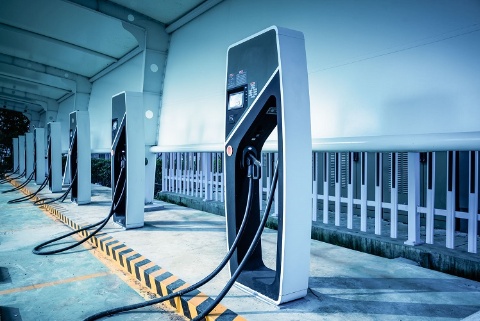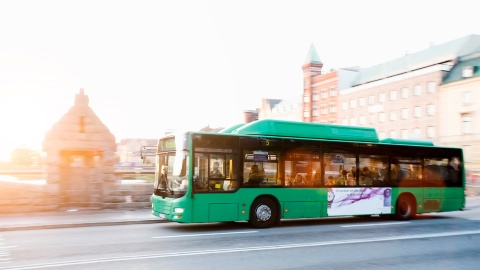
It is not only cars that can be powered by electricity, but also commercial vehicles like buses, trucks, vans or vehicles used in agriculture and the building industry. The e-models are more eco-friendly, quieter and more efficient than ones with a combustion engine. Yet before commercial vehicles can be electrified across the board, a number of challenges still have to be mastered.
Buses, construction vehicles, garbage trucks, small vans: There are far more vehicles on our roads than just passenger cars. On top of that there are large trucks and agricultural vehicles such as tractors. Most of them are still powered by fossil fuels, i.e. diesel. Moreover, commercial vehicles need a lot fuel – and so consume far more diesel than a car. Yet fossil fuels like oil are finite. They also cause huge air pollution: In the EU, commercial vehicles are responsible for 25 percent of the CO2 emissions produced by traffic – and so for five percent of total greenhouse gas emissions.
The situation will become even more critical down the road: The UN estimates that the world’s population will grow to 9.8 billion by 2050. They will have to get from A to B and be supplied with goods. Farmers will grow more food and buildings will be erected. In turn, more commercial vehicles mean more exhaust gases and more noise. Since around 70 percent of people will live in cities in the future, the situation in them will worsen. Consequently, more and more cities might then ban vehicles with combustion engines so as to protect the environment and their citizens’ health.
Their tasks will then be taken over by electrically powered buses, trucks, tractors and excavators. They do not need fossil fuels and do not produce any emissions. There are already some electric commercial vehicles on our roads, and some countries have more of them than others: China, for instance, is a forerunner when it comes to the use of e-buses. It has already realized that electrification of commercial vehicles offers great opportunities and advantages. However, there are also challenges that still have to be overcome.

Electrification of commercial vehicles
Electric commercial vehicles are powered by electricity instead of diesel or gasoline. They can be buses, vans, trucks, agricultural vehicles, such as combine harvesters or tractors, and construction machinery such as excavators or wheel loaders. The energy to drive them comes from an on-board battery, which is recharged from the power grid. As in an e-car, the electric motor converts the electrical energy into mechanical energy. One of the key components in the electrical system is the DC-to-DC converter, which supplies the power network. The drive’s inverter converts the battery’s direct current into the alternating current required to power the vehicle.
However, the issue of electrification in relation to commercial vehicles is not just confined to the drive itself. Tools, air-conditioning systems as well as superstructures and attachments can be electrified. In hybrid models, some of the power used to drive them comes from a combustion engine – the electric drive supplies the additional torque to deal with peak loads.
Why are electrified commercial vehicles important?
Electrification will grow in importance in the coming years and decades. The climate protection targets defined in the 2016 Paris Agreement are ambitious: All transport is to be zero emission by 2050. That means countries worldwide have to cut their traffic-related emissions. Some, such as the U.S., Canada, China, Japan and India, have already introduced thresholds for commercial vehicles. The EU is slowly following suit: The average CO2 emissions of heavy-duty commercial vehicles there are to be at least 30 percent below 2019 levels by 2030.

The advantages of electric commercial vehicles
The advantages of electric commercial vehicles are obvious: They do not consume any fossil fuels or emit any CO2 in operation. If their electricity comes from renewable sources, they are completely clean. There are other benefits: An electric drive consists of fewer parts, especially moving ones. That means rarer breakdowns and less servicing – and that makes the vehicles cheaper to run. Because e-vehicles have a less complex design, they can also be built to be more compact. A further advantage: They make less noise than vehicles with a combustion engine. And they are also more efficient – they accelerate more powerfully and a large part of the energy can be recovered by electric braking.
Other components apart from the drive can be electrified. In commercial vehicles with a combustion engine, the latter also drives auxiliary units such as hydraulic pumps, saws, rotating brushes, balers, mowing machines or air-conditioning compressors. The power for that is linked to the engine’s speed. However, the efficiency of ancillary units can be increased with an electric instead of a hydraulic drive; they can be driven individually and with greater power.

The evolution of commercial vehicle electrification
Werner von Siemens was a pioneer of electromobility: He not only presented (in 1867) his electric generator, which enabled vehicles to be electrified in the first place. In 1882 he also came out with the Electromote, the world’s first electric commercial vehicle and the forerunner of the trolleybus. It was the second-ever e-vehicle after Gustave Trouvé’s battery-driven tricycle dating from 1881.
Siemens’ vehicle operated with the aid of electricity from an overhead line on a 540-meter trial track in a suburb of Berlin. 18 years later, it was used as part of the regular local public transport service in Paris. Alongside that other cities, such as Berlin and Vienna, introduced various models of battery-driven buses without overhead power lines. However, operation of them was usually soon discontinued due to technical difficulties.

Some fire engines or garbage trucks were electrically driven for a time from the turn of the century to the 1920s, mainly in German municipalities and cities. Various hybrid models also emerged. However, the development of electric commercial vehicles was soon stopped because fossil fuels such as gasoline and diesel were cheaper than electricity and trucks with a conventional drive were more powerful. There was one exception: The postal service used electric vans until well into the 1960s and they had a range of just under 30 kilometers.
E-buses have undergone a renaissance since the beginning of the 21st century – initially on a small scale, although their numbers are now on the rise.

Electric commercial vehicles on the road
Most electric commercial vehicles so far are buses in cities. China is by far the forerunner when it comes to making e-buses. Other models come from Spain, France and the U.S., while German manufacturers are slowly following suit. Development of other commercial vehicles is more restrained. Well-known European manufacturers are making all larger trucks, but initially only in small series.
China, the forerunner in e-buses
Almost every one-in-five buses in China now runs without a combustion engine – and the number is rising. 115,000 e-buses were registered there in 2016 alone. By comparison: According to the German Federal Motor Transport Authority, there were 168 electric and 318 hybrid buses, but just under 79,500 diesel ones, in the whole of Germany at the beginning of 2018. In contrast, the Chinese city of Shenzhen, which has a population running into the double-digit millions, has converted its entire bus fleet to electricity – the world’s first major city to do so. More than 16,400 e-buses are now in service there. 510 bus charging stations with 8,000 charging points are dotted around the city. The aim is to cut CO2 emissions by 1.35 million tons a year. Likewise, e-buses are now mainly developed in China. The government wants to gradually replace diesel buses with e-buses in large cities. That is why production of them has been subsidized since 2009.
China is also far ahead when it comes to the use of electric buses: There are around 385,000 e-buses on the road worldwide – 99 percent of them in the People’s Republic, according to Bloomberg New Energy Finance (BNEF). In Europe, the Netherlands lead the way when it comes to electric buses: Amsterdam’s Schiphol Airport runs Europe’s largest electric bus fleet which contains 258 busses. They are used to transfer the passengers to their planes and around the local area. Currently, the Netherlands operate more than 1,000 electric busses. A number which is expected to be increased by around 20 percent within five years.
E-buses are also used in other countries. In the Swiss health resort of Zermatt, e-buses have carried spa guests through the car-free town center since 1988. There have been e-buses on some routes in Genoa and Turin since 2002. In Germany, the city of Braunschweig offers e-buses since 2014, Münster and Berlin since 2015. As of today, 676 e-buses drive around in Germany. However, this number will increase strongly, as 3,100 further e-buses are planned to enter service. Some of the school buses in California are electrically powered. London has had e-buses since 2013 and its entire bus fleet is to be electrified by 2037.
E-trucks have typically been used to date for distribution in city centers, such as to supply supermarkets or for courier services. That is because these vehicles do not have to cover long distances.
The StreetScooter from Deutsche Post
The German postal service Deutsche Post is leading the way when it comes to electric vans: Since mid-2016, the company has produced its StreetScooter, an in-house development that delivers letters and parcels. There are already 6,000 of them on the road. They have a maximum speed of 85 km/h and can cover a distance of up to 118 kilometers on a single charge. The vehicles can carry a load of up to 720 kilograms at present and a larger model is planned. Mercedes intends to compete with Deutsche Post from 2020 on with electric delivery vans for the parcel delivery company Hermes. Electrically driven 7.5-ton trucks, called Cargohoppers, are already in operation in the largest Dutch cities.
There are also more and more electric models for machines used in the building industry and agriculture, such as yard and wheel loaders and self-propelled feed mixers. Various tractor manufacturers are working on models that are to be launched soon. A number of large construction machines, such as dump trucks or cement mixers, are already powered by electricity. The Lynx dump truck is used in Switzerland: It transports rocks to the valley from a quarrying site. It weighs 123 tons when fully loaded. When driving down into the valley, the Lynx produces enough electricity to power it back uphill. The 944 from John Deere or the D7E from Caterpillar are wheel loaders that are currently the largest construction machines with an electric powertrain; both of them are hybrids.
What range is now possible
Up to now, electric commercial vehicles such as buses or trucks can travel a distance of 200 to 300 kilometers on a single charge. Their range depends on how quickly they go and whether the heating or air-conditioning, for example, is used. Yet it will grow as battery capacities increase and charging technology advances. The U.S. manufacturer Proterra set a record: The e-bus Catalyst E2 Max covered a distance of almost 1,800 kilometers on one charge.

The challenge for long-haul trucks
Electrification of long-haul trucks is still a tough nut to crack: The batteries they would need on board are still too large and heavy. One idea to solve that is trucks powered by overhead lines: The vehicles are driven by electricity and recharge their battery at the same time. A blanket network of overhead lines would not be required; they only need to be available on individual sections of a highway. Trucks equipped with pantographs have been on Sweden’s roads since 2016. The concept will also be tested in Germany, initially in Schleswig-Holstein, as of the end of 2018, and also on the highway between Frankfurt and Darmstadt from 2019 on.
Another solution for long distances could be to use fuel cells. Several manufacturers are already working on test vehicles. The advantage: The vehicles could be fitted with several hydrogen tanks in their underbody. Their weight would be less than that of batteries delivering a similar range. However, there are still too few service stations for that at present.
That is also why other ways to reduce CO2 emissions from long-hauls trucks are mostly being tried at the moment. One option is platooning, where automated, networked trucks drive closely behind each other in a convoy. That ensures traffic flows better, saves fuel and reduces greenhouse gas emissions such as carbon dioxide. The North American Council for Freight Efficiency (NACFE) has calculated that platooning can reduce fuel consumption by up to ten percent per vehicle.
Special case: conversion of diesel vehicles to e-vehicles
Instead of purchasing new e-vehicles, municipalities can also convert their existing commercial vehicles. The technical term for that is “retrofitting.” The Bavarian company Paul has been pursuing such a concept for a number of months: It is removing the conventional powertrain, essentially the engine and transmission, from vans and installing a new electric drive in them.

Challenges facing electric commercial vehicles
Electric buses, trucks and other commercial vehicles also have disadvantages over vehicles with a combustion engine as things stand at present. The price of electric vehicles is still higher at the moment. Up to now, they also cannot travel as far on a single charge as a vehicle with a combustion engine. Consequently, e-buses are used almost exclusively in cities. Larger batteries would be needed to deliver a greater range. Recharging buses and trucks also takes longer than refueling them – and the charging infrastructure is not yet ideal. A diesel-powered truck can be refueled at any service station, whereas drivers of an e-truck first have to find the right charging station and get to it.
Commercial vehicles must overcome further challenges an e-car does not encounter. They are heavier and so need larger and more powerful batteries to start with. They also have to be more resilient than a passenger car – commercial vehicles used in construction or agriculture are exposed to strong vibrations, for instance.

High demands
Stop-and-go driving is a problem e-buses often face, i.e. they brake and accelerate more frequently. They also cover a greater distance and drive longer every day: an average of at least 100 kilometers over ten hours – whereas a car only covers up to 50 kilometers over an average of one hour, as Dr. Martin Schulz, power electronics expert at Infineon, explains. The lifecycle of the parts in a commercial vehicle is therefore around 60,000 hours, compared to the 8,000 hours for parts in passenger cars. Moreover, buses travel a far greater total distance over their service life: typically more than one million kilometers compared to just up to 200,000 for a car. All that has an impact on the power electronics on board: The electronic parts must also be more robust and durable.
The demand for comfort also entails difficulties for electric buses: Their range may be reduced if power from the battery is used for heating or air conditioning. The models would also need more powerful and larger batteries to cope with that – or innovative solutions to regulate the temperature have to be found.

Challenges facing the charging technology and batteries
One of the biggest challenges, especially for e-buses, is recharging the battery: They cannot be driven when they are “refueling.” However, they cannot be withdrawn from service for several hours, either. The larger the batteries, the further a bus can journey on a single charge. However, that reduces capacity in the bus, i.e. the number of seats – and means greater weight. Yet the heavier the vehicle is, the more energy it requires.
That is why manufacturers and suppliers are focusing on making batteries and the charging technology more efficient. They are searching for better ways to supply batteries with hundreds of kilowatt hours of energy in a very short time, as Dr. Martin Schulz explains. There are various approaches here, each with their advantages and drawbacks.
One possibility is to briefly recharge the batteries while passengers get on and off at bus stops. That means smaller batteries can be used. However, that puts a heavy strain on the battery, since a lot of electricity has to be fed into it in a short space of time. One alternative would be to set up charging stations in the middle or at the end of a route and allow the bus to wait longer there to recharge, for example for half an hour. As it is, the driver has to schedule such a break anyway. Or else the charging infrastructure is established at the depot. The bus battery would then be recharged only overnight. The advantage: No new charging stations are needed and slow recharging is gentler on the batteries. However, that demands big batteries with large capacities. Some Chinese e-buses use the “battery swapping” system: Empty batteries are replaced by freshly charged ones at specific stations.

A further difficulty: There is still no global standard for the systems used to charge electric commercial vehicles. Europe and North America use a different system to China or Japan. The various possibilities are currently being tested and discussed. It is still not certain which system will come out on top. However, each of them makes high demands on power semiconductors.

Infineon and electric commercial vehicles
Infineon helps to make electric commercial vehicles possible in numerous ways. The field of activity of the Commercial, Construction and Agricultural Vehicles division covers vans and buses, as well as agricultural machines and large vehicles in the building trade.
The big goal: To slash CO2 emissions by, for example, electrifying local public transport worldwide. However, the wide range of different requirements demanded of power semiconductors is not easy to meet in electrification of commercial vehicles. One major factor here is the service life required for the electronics. Many commercial vehicles also have to work under extreme conditions – strong vibrations are a challenge in particular. Protecting buses against vibrations certainly makes sense – but it is vital for heavy-duty machines in construction, on poor road surfaces or in quarries. That is why Infineon is developing semiconductors that increase stability and meet the very highest demands. Power modules like PrimePACK™ and EconoDUAL™ 3 are specifically designed to handle the high strains put on heavy-duty commercial vehicles and can also cope with mechanical stress as a result of vibrations. For example, Infineon is supporting the construction of especially compact and reliable inverter systems, also for the most challenging applications.
New materials, new opportunities
It is also important for the capacity and service life of batteries to be increased. The battery takes up a lot of space in the vehicle and is one of the cost drivers. Highly efficient power electronics are therefore needed to get the most out of the available capacity: By delivering state-of-the-art components – based for example on silicon carbide (SiC) –, Infineon will help to put more efficient commercial vehicles on the road and also increase their range.
But achieving that requires not only the vehicles themselves, but also the charging infrastructure to match, explains Dr. Martin Schulz. That is why Infineon is working to make recharging faster and more efficient. Materials like silicon carbide (SiC) and gallium nitride (GaN) allow components that are smaller and more efficient than their predecessors to be produced. Higher charging performance – currently up to 350 kW – means long waits for the battery to be charged will soon be a thing of the past.

Outlook
Electrified commercial vehicles will be an increasingly common sight on roads in the future. According to a study by McKinsey, e-trucks such as vans or articulated lorries will account for around 15 percent of the total market in 2030. Its researchers estimate that the share of smaller commercial vehicles in cities in China and Europe will be 35 percent. The research company Bloomberg New Energy Finance (BNEF) forecasts that 80 percent of buses in cities worldwide will be electrified by 2040.

A further trend will help to underpin that development: If trucks drive autonomously, for example, and are networked with other trucks, they can drive in convoys and so save energy. Better and also cheaper batteries will also reduce the charging time and increase ranges moving ahead. Daimler Trucks has done some calculations here: The company expects the costs of batteries for an e-truck to fall – by 60 percent by 2025 compared to 1997 or from €500/kWh to €200/kWh. The energy density will also increase in this period from 80 Wh/kg to 200 Wh/kg. The more efficient the batteries are and the faster they are charged, the more attractive electric commercial vehicles become – in addition to all the advantages this eco-friendly and efficient drive technology already offers.
Last update: July 2021






